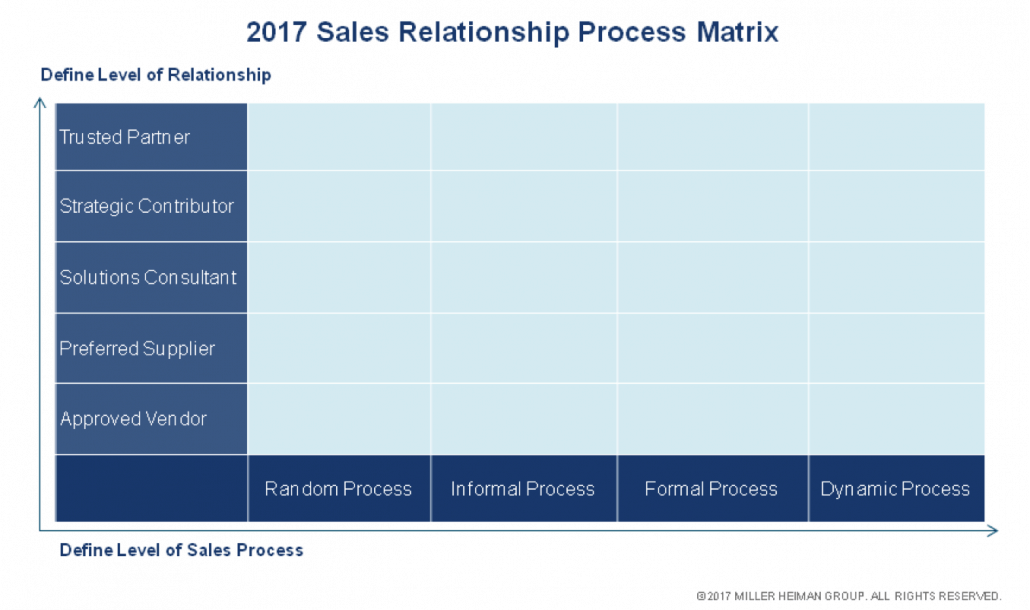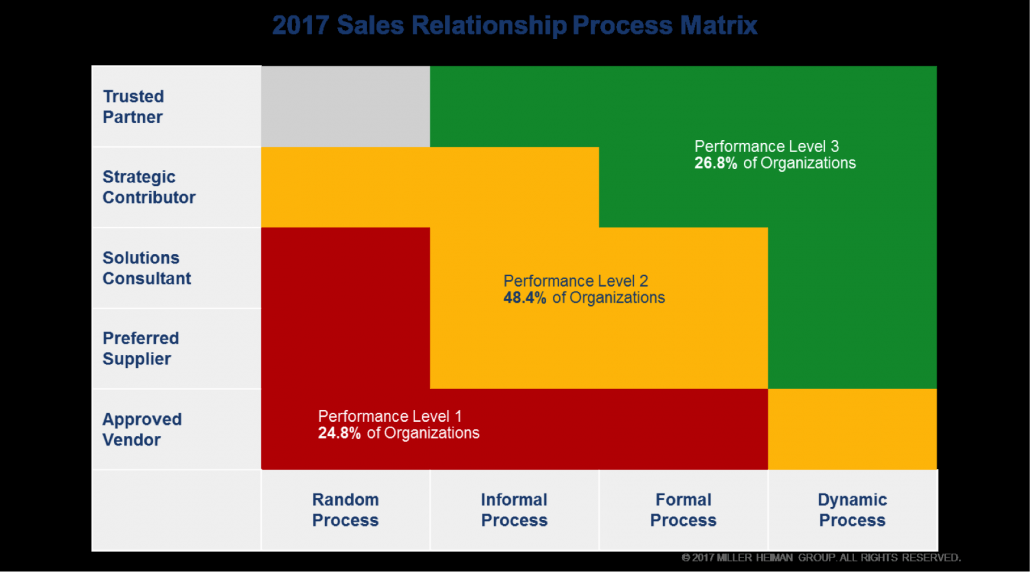What the 2017 CSO Insights World-Class Sales Practices Report means for Key Account Managers
in Key Account Management /Key Account Management is not a division of sales, but there is plenty to learn from how sales works that Key Account Managers (KAMs) can apply directly to their work. Key Account Managers don’t work for the sales department, but sales practices are still a strong part of what KAMs do. Working with key accounts is about maximizing revenues from key accounts by working towards mutually beneficial goals. It’s essentially a long-term relationship building strategy for cross-selling and up-selling.
With that in mind, Key Account Managers can benefit from understanding the best practices that are applied in sales, particularly in areas like relationship building. B2B sales have a lot in common with what KAMs are trying to accomplish, although they may have different end goals in mind.
Miller Heiman: 2017 CSO Insights World-Class Sales Practices Report
In 2017, Miller Heiman released an insightful report on the best practices used by top sales companies to accomplish their revenue goals and reach their sales quotas. The report focuses on the need for forward momentum in an ever-changing sales environment. According to their research, it is impossible to maintain the status quo in today’s sales environment. You must either move forward or else you will automatically move backwards, just as if you were attempting to run up a down escalator.
Because of this, customer relationships and your actual sales process are emphasized as a way to continue moving forward without falling behind. The main focus of the report is to show the best practices used by top sales departments to maintain strong customer relationships, create dynamic processes, and continually encourage forward momentum in sales. We can take some of the advice given about relationship building and apply it directly to the work of Key Account Managers.
Copying Proven Best Practices
It may not be possible to copy the exact results of the top companies in sales and key account management, but it is possible to emulate the strategies and best practices they implemented to reach their results. As a Key Account Manager, it’s your responsibility to observe what others are doing to advance their position with their customers and to apply what you can to do the same in your own company. Many practices that relation-focused sales departments use can be applied by KAMs as well.
The top performing companies in sales standards are those that hit their account quotas as well as revenue goals. For Key Account Managers, revenue goals are also important, but they are not the only focus as the methodology used to reach those goals matters a lot. Long-term, sustainable revenue gains are preferred over short-term strategies aimed only at hitting revenue targets. For this reason, those companies that demonstrate a better method for consistently reproducing strong customer relationships are the companies which should be modeled by KAMs.
The Relationship Process Matrix (Updated)
In some form or another, the relationship process matrix (RPM) has existed for years. CSO Insights recently updated the previous versions to bring a more relevant matrix for today’s business climate. Before going over the matrix itself, it’s beneficial to understand each of the levels represented on the X and Y axes. There are two measures included: customer relationship stage and process complexity.
These are the explanations of each of the customer relationship stages and also the process complexity:
Stages of Customer Relationship
- Approved Vendor
At the beginning of a relationship with customers, the company has been authorized as a vendor for the customer and may supply some goods or services. In most cases, the company will be one of multiple approved vendors for a particular good or service.
- Preferred Supplier
Once a company has proven to be a reliable supplier, they may become a preferred supplier for the customer. At this stage, the company will have some understanding of the customer’s business, how they use the products, and multiple contacts within their organization.
- Solutions Consultant
When a company passes the stage of being a preferred supplier, the next step is generally to begin sort of consultancy role, although it may not be specified in a title or deal. At this point, the company is valued for more than just their products and services, but the customer also values the knowledge and understanding the company can provide to help the customer succeed.
- Strategic Contributor
Having the same qualities as the solutions consultant stage, the company is also understood to have expertise in their field, industry, or domain and is valued by the customer for that knowledge as well as the products or services provided. The customer is likely to ask for the company’s contributions on its own internal discussions.
- Trusted Partner
Having all of the same qualities as a strategic contributor, a trusted partner holds unique knowledge of the inner workings of the customer and is able to work together with them for mutually beneficial goals. Trusted partners are highly involved with their customers and are seen as a valuable resource for their contributions, expertise, and strong relationship with the customer.
Process Complexity & Implementation
- Random
These are processes which are decided by each individual and not dictated by the company itself. Random processes exist when no formal process exists at all, recognized or not, and all the employees have their own way of doing things with no real guidance from the company.
- Informal
Sometimes a company may come up with processes and even write them down, but the employees do not really follow them. When the processes, methods, and documented steps are not enforced, even though employees are expected to follow them, they are considered informal.
- Formal
Formal processes are those that exist in documentation and are enforced by management. Employees understand the processes and are fully expected to follow them. In many companies, formal processes are known as the Standard Operating Procedures (SOP) and are used as the guiding principles for the organization.
- Dynamic
In organizations with formal processes in existence, the next step in complexity is to add in consistent refining based on data and analytics. The additional data gathering and studying helps the organization to adjust rapidly when changes are needed in the process, with the intention of keeping the company moving forward as the business climate changes.
With an understanding of what each level represents, it’s easier to read the RPM and understand where your company fits. Following is the 2017 RPM from Miller Heiman CSO Insights:

Companies that fit into the lower left area of the chart are those with generally more short-term, transactional relationships with customers, while those in the upper right have long-tern, sustainable partnerships with customers. For application in sales, there is no position on the chart that is necessarily more ideal than the others, as each company may have different needs for processes and customer relationships. However, if applied to key account management, there is a sweet spot on the chart that you need to reach for with each key account customer.
How Does the RPM Apply to Key Account Managers?
KAMs are concerned with being trusted partners to each key account. This is the initial goal with every key account. When it is reached, maintaining status as a trusted partner is never a given and should be considered the long-term goal. At the same time, KAMs need to reform their processes in order to find a method for advancing customer relationships that’s effective, replicable, and sustainable. This lands the sweet spot for KAMs on the RPM in the upper right corner of the matrix. The intersection of trusted partnership and a dynamic process is a great goal for KAMs.

As part of the research conducted by Miller Heiman, organizations were put into categories to see what position they held with their customers. In general, those companies operating in performance level 3 have the best performance in terms of meeting revenue goals and quotas, lowering customer churn, and increasing success rates of forecasted deals.
KAMs thrive in performance level 3, because this is where most of the key account management process is meant to take place. Key account plans should be the dynamic processes for each account, guiding the relationship from a preferred supplier to a trusted advisor. It is not advisable for KAMs to operate with an informal or random process, as the process should be shared with the customer and should be repeatable.
Why Dynamic Processes Are Important
Just like sales, key account management is not done in a vacuum. It is not a static and unmoving environment. No matter how good your formal process may be, there is a good chance it won’t be enough to keep you on top when things begin to change. You need to be able to rapidly adapt to new conditions, including more discerning buyers, disruptive or new technologies, marketplace uncertainty, changes in buyer needs, and more.
Without a dynamic process, you will have difficulty adjusting to keep up the forward momentum. As things are changing, staying still will eventually put you behind the pack, no matter how far ahead you are right now. If you allow your competitors to keep making small advances, they will eventually overtake you by surprise.
You need to be willing to adjust to your changing climate quickly. KAMs need to take out the key account plan often and make sure everything that’s contained inside is still relevant and will help them to move forward continually. Without this constant revision of the key account plan (the KAM’s “process”), you cannot expect to maintain your status with the customer in the long-term.
Thinking of consistently updating and changing your plan can be intimidating, but it shouldn’t scare you away. A dynamic process simply means that you don’t stick to the way it’s always been done if you find out information that points you in a different direction. Change is usually viewed as unpleasant, but it must embraced. Don’t be afraid of change, because change can mean the difference between proactive and reactive industry movement.
Dynamic processes are proactive and will make moves to avoid obstacles and tackle challenges before they become overwhelming. By observing the relevant data, you can look into changes that are occurring and tweak your key account plan to make it more suitable for what’s to come. If you remain the same in the face of visible changes, however slight, you will have a difficult time adjusting enough when those changes force you to react. Staying ahead of the curve requires you to consistently look at your plans and see if they measure up to what needs to be happening.
Where Are You with Your Key Accounts?
As a helpful diagnostic, you can check the RPM to find your positions with each of your key accounts. This will help you to know where you may need improvement and in what way you could advance your relationship further. Stepping back and honestly evaluating your company on the RPM can assist you in getting a better perspective on the work you’re doing to create partnerships.
Examine each one of your key accounts and see where you fit into the matrix. This is going to help you create your plan to move forward with every account while also helping you track your progress along the way.
How to Use Kapta to Improve Your Process
Dynamic key account plans don’t work unless you set yourself up for victory. An effective tool is needed to help you collect, organize, and interpret data in order to make changes to your plan. A tool is especially useful if it will also make it easier for you to make adjustments to the key account plans without requiring a lot of extra work.
Kapta has an efficient setup and interface for collecting and working with customer data to make better management decisions. Our software also makes it easier to keep everyone in the loop when you want to make changes. We give you simple, direct access to each of your separate account plans, proactive alerts about potential risks, connection with your whole team and your customers, and so much more. Everything about Kapta is aimed at helping your job as a Key Account Manager easier.
If you want to give Kapta a try, you can request a free demo today to see if it’s a good fit for your organization. We haven’t made just another CRM, but a software designed specifically for KAMs by those who have been in your shoes before. Try Kapta today and see the difference it can make for you.
2017 CSO Insights World-Class Sales Practices Report is a copyright of Miller Heiman Group. All rights reserved.







